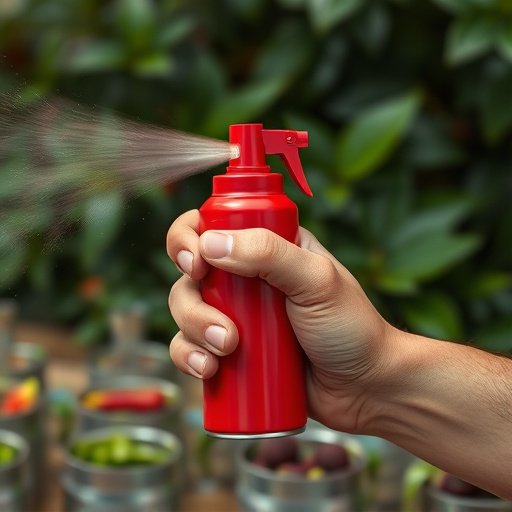The Pepper Spray Storage and Maintenance Guide emphasizes proper handling for effective riot control. It details maintenance steps like cleaning, leak checks, ventilation, recharging, and part replacement. Optimal storage locations keep spray away from children, with environmental controls to maintain stability. Regular inspections, calibrations, and adherence to guide protocols ensure reliability, lifespan, safety, and efficacy of pepper spray dispensers.
Looking for a comprehensive guide on pepper spray storage and maintenance? In this detailed overview, we explore essential aspects of managing inflammatory riot control spray dispensers. From understanding basic mechanics to implementing safety protocols, this Pepper Spray Storage and Maintenance Guide ensures optimal performance and user safety. Discover the ideal storage locations, factors affecting operability, regular inspection routines, calibration best practices, and responsible disposal methods.
- Understanding Pepper Spray Dispenser Basics
- Choosing the Right Storage Location
- Maintaining Optimal Operating Conditions
- Regular Inspection and Calibration
- Safety Protocols for Handling and Disposal
Understanding Pepper Spray Dispenser Basics
Pepper spray dispenser, a powerful tool in riot control, functions by releasing a potent chemical compound that temporarily incapacitates individuals, providing crucial time for law enforcement to restore order. Understanding its basics is key to effective deployment and safety. A typical pepper spray dispenser is designed with a reservoir holding the spray solution, a trigger mechanism, and a nozzle for targeted application.
Proper storage and maintenance are vital aspects of any Pepper Spray Storage and Maintenance Guide. Regular cleaning, checking for leaks or damage, and ensuring proper ventilation in storage areas are essential to prolonging the effectiveness and safety of the dispenser. Following manufacturer guidelines for recharging and replacing parts can significantly enhance its longevity, contributing to better riot control outcomes.
Choosing the Right Storage Location
Choosing the right storage location for your pepper spray dispenser is a crucial aspect of ensuring its effectiveness and safety. In terms of pepper spray storage and maintenance guide, it’s essential to keep it out of reach from children and unauthorized individuals. Opt for a secure, locked cabinet or safe, ideally in a high-traffic area like a police station or security control room. This strategic placement allows easy access during emergencies while maintaining control over who can use the spray.
Additionally, consider environmental factors such as temperature and humidity levels, which can impact the stability of pepper spray. It’s recommended to store them away from direct sunlight, extreme heat, or freezing conditions. A cool, dry place, like a locked drawer in a desk, can be an ideal spot. Regular maintenance involves checking the expiration date and ensuring proper functionality through occasional testing, all detailed in your pepper spray storage and maintenance guide.
Maintaining Optimal Operating Conditions
Maintaining optimal operating conditions for a pepper spray dispenser involves adhering to a strict storage and maintenance guide. Firstly, store the device in a cool, dry place away from direct sunlight or extreme temperatures. Secondly, keep it out of reach of children and unauthorized individuals to prevent accidental discharge. Regular cleaning and inspection are crucial; use a soft cloth to wipe down the exterior and ensure no debris blocks the nozzle. Check the spray pressure indicator regularly; most dispensers have a recommended pressure range, and any deviation may require recalibration or replacement. Additionally, inspect the spray mechanism for any signs of damage or wear, as these can impact effectiveness. Following a comprehensive pepper spray storage and maintenance guide ensures the device remains reliable when needed, maximizing its operational lifespan.
Regular Inspection and Calibration
Regular inspection and calibration are vital components of a comprehensive pepper spray storage and maintenance guide. To ensure optimal performance, devices should be checked periodically for any signs of damage, wear, or corrosion. This includes examining the nozzle for clogging or debris and verifying that the spray mechanism functions correctly. Calibration involves testing the accuracy and potency of the spray, ensuring it meets the manufacturer’s specified standards. By adhering to a strict inspection and calibration schedule, users can be confident in the reliability of their pepper spray during emergency situations.
Safety Protocols for Handling and Disposal
When handling a pepper spray dispenser, safety protocols must be strictly adhered to. This includes wearing appropriate protective gear such as gloves and goggles during use and storage. It’s crucial to keep the device out of reach of children and unauthorized individuals, storing it in a secure, cool, dry place away from direct sunlight or extreme temperatures.
For disposal, pepper spray should never be disposed of down the drain or in regular trash. Instead, consult local regulations for proper disposal methods, which may involve specialized collection points or hazardous waste facilities. Following the Pepper Spray Storage and Maintenance Guide ensures not only the effectiveness of the device but also the safety of everyone involved.
A well-maintained pepper spray dispenser is a vital tool for effective riot control, ensuring public safety in various scenarios. By understanding the basics, selecting the right storage location, and adhering to safety protocols, you can maximize its potential. Regular inspection, calibration, and proper disposal practices are essential components of our comprehensive Pepper Spray Storage and Maintenance Guide, enabling you to stay prepared and responsive in challenging situations.
